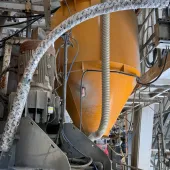Breakthrough System Rises to Emissions Challenge

First published in the April 2016 issue of Quarry Management
The energy efficiency challenges facing the quarry industry are numerous and difficult. Here, Adam Patterson of Multi Source Power, examines how new breakthrough technology can address the issue
The need to become more energy efficient within the quarrying industry is something that is not going to go away, with many operators working hard to address the issue, while also reducing costs. Tough government targets include cutting carbon emissions by 50% and cutting overall costs by 2025, with the UK committing to reducing carbon emissions by 80% by 2050.
Research and studies often come to the same conclusion – that improving the efficiency of equipment and using greener energy is the answer. However, the key to achieving that efficiency goal is to ensure the relevant technology is in place. Part of the solution lies in the supply of power itself. The generators used in quarries, from those powering hammers and drills to those providing lighting, consume high levels of energy.
Quarry operators worldwide are implementing programmes to reduce their carbon emissions and, by analysing the energy performance of the equipment used, identifying what times of day they are using energy and how it can minimized. Often generators are running continually for weeks, months and sometimes years, and while it is vital they are reliable to prevent costly downtime, running at that level could become problematic.
For example, large machinery often has equally large start-up loads – so they require a bigger generator – but usually the start-up lasts for no longer than a minute, meaning the average load throughout the day is much lower but the oversized generator means vast amounts of diesel are being burned unnecessarily. Moreover, energy is also wasted overnight when lighting and security systems are being powered by diesel generators.
Peak shaving could be the answer to both of these problems. Going off-grid or switching to stored supplies has the potential to make a huge difference in how much energy is used. According to Multi Source Power (MSP), new hybrid power system technology is bringing new benefits with its clean, lightweight operational efficiencies – which can address carbon reductions within the quarrying industry.
Using wind, solar or diesel power, the technology is said to offer vastly reduced downtime with its reliability of power electronics relevant for integrating into conventional grid systems. With its significant reduction in carbon emissions – coupled with its compact design and silent operation – the hybrid power-management and storage system offers new opportunities for sustainable power from multiple sources, which can be adapted for quarrying and mining.
Essentially, this is mobile green power which can meet higher power demands than other hybrid power technology. It also allows energy renewables to play a part in the energy mix – making renewables more viable for smaller quarry owners. This hybrid power system can also tick the peak shaving box, because the power comes from the batteries within it and the diesel is only burned when it is needed.
The system is smaller in both size and weight making it more mobile so it can meet the demands of evolving quarries and the need to move machinery. Importantly, it can provide uninterrupted instant power in off-grid locations, making it particularly suitable for remote quarries. As well as helping to reduce emissions, systems such as this also reduce maintenance costs/visits, as well as noise. Workers on site will benefit from improved air quality within the working environment and less noise around the site.
MSP’s own research found that a 140kVA generator running for 12h a day in a working mine ran at an average of 60kVA. On occasion the power-requirements did reach almost 140kVA, but only for start-up loads which lasted for a few seconds – a good example of a generator running inefficiently. The difference that this breakthrough technology brings to the market, is only the kilowatts required would be used.
The power comes from the batteries, so the diesel generator only comes on when the batteries need topping up, greatly reducing the running time of the diesel generator. This could also be combined with renewables, meaning the diesel element might not be used at all. However, although the hybrid power system has the capability of eliminating the diesel element, this requires the correct amount of renewables, and because the sun does not always shine, nor does the wind always blow, the diesel element is important to guarantee constant power.
According to MSP, there is currently nothing on the market to compare with this technology. It is clean, efficient, lightweight and reliable for a diverse range of uses, while additional benefits include a longer-lasting lithium-based battery life cycle, a digital switching mechanism and peak buffering with easy plug-and-play installation for the end-user.
For more information visit: www.multisourcepower.com.








